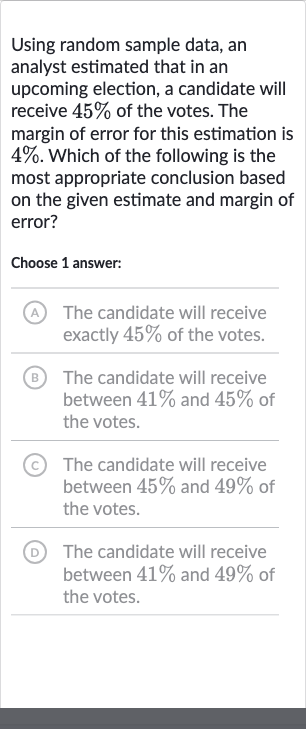AI tutor
Welcome to Bytelearn!
Let’s check out your problem:

Using random sample data, an analyst estimated that in an upcoming election, a candidate will receive of the votes. The margin of error for this estimation is . Which of the following is the most appropriate conclusion based on the given estimate and margin of error?Choose answer:(A) The candidate will receive exactly of the votes.(B) The candidate will receive between and of the votes.(C) The candidate will receive between and of the votes.(D) The candidate will receive between and of the votes.
Full solution
Q. Using random sample data, an analyst estimated that in an upcoming election, a candidate will receive of the votes. The margin of error for this estimation is . Which of the following is the most appropriate conclusion based on the given estimate and margin of error?Choose answer:(A) The candidate will receive exactly of the votes.(B) The candidate will receive between and of the votes.(C) The candidate will receive between and of the votes.(D) The candidate will receive between and of the votes.
- Margin of Error Explanation: Understand the concept of margin of error. The margin of error in a statistical estimate represents the range within which the true value is expected to lie with a certain level of confidence. In this case, the margin of error is , which means the true percentage of votes the candidate will receive could be higher or lower than the estimated .
- Calculate Lower Bound: Calculate the lower bound of the estimate.To find the lower bound, subtract the margin of error from the estimated percentage.Lower bound = Estimated percentage - Margin of errorLower bound = Lower bound =
- Calculate Upper Bound: Calculate the upper bound of the estimate.To find the upper bound, add the margin of error to the estimated percentage.Upper bound Upper bound Upper bound
- Determine Range: Combine the lower and upper bounds to determine the range.The candidate is estimated to receive between and of the votes, taking into account the margin of error.
More problems from Interpret confidence intervals for population means
QuestionGet tutor help
QuestionGet tutor help
QuestionGet tutor help
QuestionGet tutor help
QuestionGet tutor help
QuestionGet tutor help
QuestionGet tutor help
